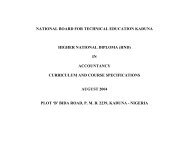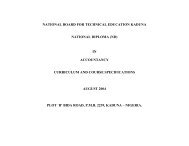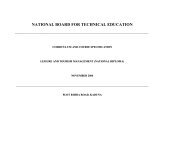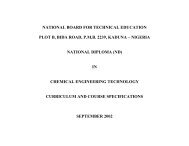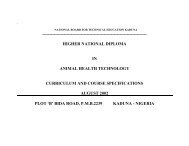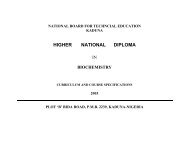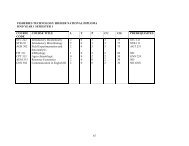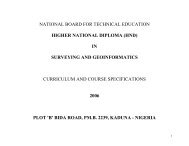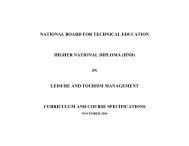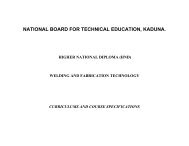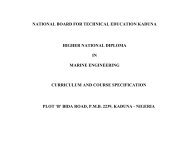The Semester & The Course Unit Systems - Yaba College of ...
The Semester & The Course Unit Systems - Yaba College of ...
The Semester & The Course Unit Systems - Yaba College of ...
Create successful ePaper yourself
Turn your PDF publications into a flip-book with our unique Google optimized e-Paper software.
7.0 <strong>The</strong> <strong>Semester</strong> & <strong>The</strong> <strong>Course</strong> <strong>Unit</strong> <strong>Systems</strong><br />
7.1 <strong>Semester</strong> System<br />
<strong>The</strong> semester system and the course unit system as approved by the Academic<br />
Board have been in operation in the <strong>College</strong> since the 1988.89 Session.<br />
<strong>The</strong> semester system breaks an academic session into two periods <strong>of</strong> lectures <strong>of</strong><br />
15-17 weeks. A normal academic session usually commences in October and ends<br />
in July <strong>of</strong> the following year giving a total <strong>of</strong> some 37 weeks.<br />
<strong>The</strong> break down is usually as follows:<br />
i. First <strong>Semester</strong><br />
17 weeks (say)<br />
2 weeks - Registration/orientation<br />
13 weeks - Lectures<br />
2 weeks - 1st semester examinations<br />
ii. Second <strong>Semester</strong><br />
16 weeks (say)<br />
1 weeks - Registration<br />
13 weeks - Lectures<br />
2 weeks - 2nd semester examinations<br />
7.2 <strong>The</strong> <strong>Course</strong> <strong>Unit</strong> System<br />
<strong>The</strong> <strong>Course</strong> <strong>Unit</strong> System (CUS) is a credit system based on the premise that fields<br />
<strong>of</strong> knowledge can be broken down into small components called courses/modules<br />
that can be arranged in some convenient pedagogical way.<br />
Although it is now the usual practice to operate the CUS with the <strong>Semester</strong> System,<br />
It is to be noted that the combination is not necessarily imperative.<br />
One <strong>of</strong> the objective <strong>of</strong> the CUS is the provision <strong>of</strong> flexibility through a variety od<br />
combination <strong>of</strong> approved courses.<br />
Among its advantages are the following:<br />
1. because courses are broken down into modules with examinations given at<br />
the end <strong>of</strong> each semester, the former practice <strong>of</strong> conducting one<br />
A cross section <strong>of</strong> students <strong>of</strong> <strong>Yaba</strong> <strong>College</strong> <strong>of</strong> Technology, during<br />
orientation programme for new students
comprehensive examination at the end <strong>of</strong> the session is eliminated.<br />
ii.<br />
iii.<br />
students transfer from one institution to another or from one programme to<br />
another is more easily facilitated.<br />
students can progress at their own pace.<br />
7.2.1 DEFINITION OF TERMS<br />
a. A course<br />
Subject <strong>of</strong>fered for a number <strong>of</strong> honours per week<br />
b. <strong>Course</strong> <strong>Unit</strong><br />
1. <strong>Course</strong> <strong>Unit</strong> = 1 Lecture hour per week<br />
= 2 tutorial hours per week<br />
= 2/3/4 Laboratory/Workshop practice<br />
hours per week<br />
A <strong>Course</strong> carries a minimum <strong>of</strong> one course unit and a maximum <strong>of</strong> four course<br />
units.<br />
<strong>The</strong> maximum number <strong>of</strong> course units a student can <strong>of</strong>fer per semester is 24 and<br />
the minimum is 15 for full time students. <strong>The</strong> corresponding figures are 16 and 10<br />
respectively for part-time students.<br />
c. Core <strong>Course</strong>s<br />
<strong>The</strong>se are major courses required to be taken and passed by the student majoring<br />
in a particular field <strong>of</strong> study.<br />
d. Compulsory <strong>Course</strong>s<br />
<strong>The</strong>se are courses required to be taken and passed by all students, e.g. General<br />
Studies is a compulsory course.<br />
e. Elective <strong>Course</strong>s<br />
<strong>The</strong>se are not necessarily directly-relevant to the programme <strong>of</strong> study, but which a<br />
student decides to take. It is observed however that in a good number <strong>of</strong> the<br />
departments, students do not take any elective courses.<br />
f. Optional <strong>Course</strong>s<br />
<strong>The</strong>se are major courses from which a student can select his specific area <strong>of</strong> interest.
g. Pre-requisites<br />
Pre-requisite courses are courses which are essential to the understanding <strong>of</strong><br />
another higher course and which must be passed before the student can take the<br />
higher course.<br />
7.2.2 COURSE CODE<br />
<strong>The</strong> code for each course is made up <strong>of</strong> three alphabets and three digits. e.g.<br />
STC 317, BAM 101, EEC 202 etc.<br />
<strong>The</strong> letters represent the name <strong>of</strong> the programme, whilst the digits (depending on<br />
whether 1st, 2nd or 3rd) represent the level <strong>of</strong> the programme and also whether 1st<br />
or 2nd <strong>Semester</strong> course.<br />
e.g. STC - Science Technology<br />
BAM - Business Administration<br />
EEC - Electrical Engineering<br />
PRT - Printing Technology<br />
TRP - Town & Regional Planning etc.<br />
<strong>The</strong> first digit represents the level <strong>of</strong> the programme.<br />
e.g 0 - Certificate/Preliminary/Day Release <strong>Course</strong>s<br />
1 - ND 1<br />
2 - ND 2<br />
3 - HND 1<br />
4 - HND 2<br />
<strong>The</strong> final digit<br />
i. if odd represents 1st semester courses<br />
ii. if even represents 2nd semester courses<br />
e.g ACH 101 - This is a 1st <strong>Semester</strong> <strong>Course</strong> for ND 1 in the<br />
Department <strong>of</strong> Architecture<br />
SES 402<br />
- This is 2nd <strong>Semester</strong> <strong>Course</strong> for HND 2 in the<br />
Department <strong>of</strong> Secretarial Studies.<br />
7.2.3 GRADING<br />
i. Grading is done using the 4-points grading system and a students<br />
performance in any semester in recorde as the Grade Point Average
(GPA) which is a function <strong>of</strong> the <strong>Course</strong> <strong>Unit</strong>s and the Weighted Grade<br />
Point (WGP)<br />
<strong>The</strong> table below gives the letter grades in use and their corresponding percentage<br />
Scores and Weighted Grades.<br />
Score % Letter Grade Weighted Grade (WGP)<br />
80 and above A1 4.00<br />
70-79 A2 3.50<br />
60-69 B 3.00<br />
50-59 C 2.50<br />
40-49 D 2.00<br />
30-39 E 1.50<br />
20-29 F 1.00<br />
10-19 G 0.50<br />
0-9 H 0.00<br />
ii. Grade Point Average<br />
A student’s GPA in any semester is obtained by dividing his WGP by the total <strong>of</strong><br />
the <strong>Course</strong> <strong>Unit</strong>s <strong>of</strong> the courses taken.<br />
Consider the following table which shows a hypothetical case <strong>of</strong> a second semester<br />
performance <strong>of</strong> an HND 2, Science Technology student who has taken 6 courses<br />
<strong>Course</strong> Code <strong>Course</strong> <strong>Unit</strong>s Raw Score Letter WGP Grade<br />
Point Cu % Grade (CU * WGP)<br />
STC 432 2 62 B 3.0 6.0<br />
STC 414 4 57 C 2.5 10.0<br />
STC 422 4 53 C 2.5 10.0<br />
STC 424 2 61 B 3.0 6.0<br />
STC 426 2 72 A2 3.5 7.0<br />
STC 428 4 86 A1 4.0 16.0<br />
55.0<br />
<strong>The</strong> grade Point Average (GPA) for this Student and for the semester in question
is given as:<br />
GP(Total) 55<br />
GPA = CU(Total) = 18 = 3.06<br />
iii.<br />
iv.<br />
<strong>The</strong> Cumulative Grade Point Average<br />
<strong>The</strong> Cumulative Grade Point Average (CGPA) is the weighted average <strong>of</strong><br />
the GPA <strong>of</strong> all the semesters<br />
Absenteeism Grade<br />
If a student absent himself from examination, where the student has not<br />
<strong>of</strong>ficially withdrawn from the course, a score ZERO will be entered for the<br />
student in that <strong>Course</strong>.<br />
7.3 Classification <strong>of</strong> Diplomas<br />
Diplomas and certificate are classified from distinction to ordinary pass according<br />
to the CGPA<br />
<strong>The</strong> following table illustrates:<br />
Score % CGPA Grade<br />
70 and above 3.50 and above Distinction<br />
60-69 3.00-3.49 Upper Credit<br />
50-59 2.50-2.99 Lower Credit<br />
40-49 2.00-2.49 Pass<br />
0-39 Below 2.00 Fail<br />
CGPA below 2.00 constitution a FAILURE<br />
7.4 Academic Standing<br />
<strong>The</strong> following terms are used in determining a students academic standing at<br />
various stages <strong>of</strong> his course<br />
i. PROBATION<br />
A student is put under probation if at the end <strong>of</strong> the 2nd <strong>Semester</strong>, his GPA
fall below 2.00, provide his CGPA is not less that 1.50<br />
ii.<br />
WARNING<br />
If a student obtain a GPA less than 2.0 at the end <strong>of</strong> the 1st <strong>Semester</strong>, such<br />
a student would be issued with a LETTER OF WARNING<br />
iii. CARRY OVER<br />
In the system under operation there is no provision for RESIST <strong>of</strong><br />
examinations<br />
or REPEAT <strong>of</strong> a class. In place <strong>of</strong> these is the Carry Over<br />
(CO) facility.<br />
All failed courses (i.e grades E, F, G, & H) are treated as Carry Over provided<br />
the conditions under PROBATION is satisfied.<br />
All such Carry-Over courses must be taken at the appropriate <strong>Semester</strong>;<br />
i.e. when such courses are available.<br />
iv.<br />
WITHDRAWAL<br />
At the end <strong>of</strong> the 2nd semester, a student with a Cumulative Grade Point<br />
Average (CGPA) <strong>of</strong> below 1.50 will be asked to withdrawal from the <strong>College</strong>.<br />
“Withdrawal” does not apply after the 1st <strong>Semester</strong> examinations.<br />
<strong>The</strong> Rector, Chief (Mrs) F. A. Odugbesan, the Registrar Mrs. F. F. Taiwo<br />
and the Dean student’s Affairs, Engr. A. I. Abiodun at the foundation<br />
laying ceremony <strong>of</strong> the New Science & Technology Complex
7.5 Completion <strong>of</strong> Programme Requirements<br />
A programme is deemed to have been successfully completed if the following conditions<br />
have been met.<br />
i. CGPA is not less than 2.00<br />
ii. Project Work has been successfully completed<br />
iii. Attendance at classes is not less than 75%<br />
iv. Industrial attachment requirements successfully completed.<br />
Candidate will be entitled to the <strong>College</strong> Diploma/Certificate if in addition to meeting the<br />
above requirements, the candidate has not been found wanting in character.



